I fell in love with snake plants when I needed something easy to care for. They made my home feel calm and beautiful. I was amazed by their ability to thrive indoors.
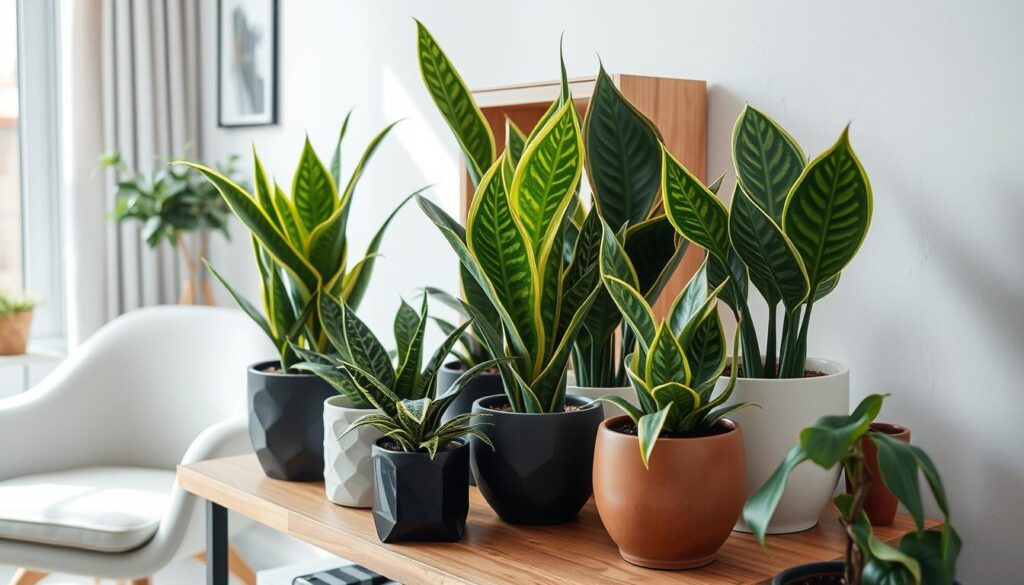
Snake plants are a favorite among plant lovers. They are easy to care for and add beauty to any room. These plants show that nature can survive and even flourish indoors.
Whether you’re new to plants or have a green thumb, snake plants are perfect. They’re easy to care for and make your home look great. Plus, they help clean the air, making them a great choice for indoor spaces.
This guide will teach you everything about snake plants. You’ll learn about their different types, how to care for them, and their benefits. Get ready to enhance your indoor gardening with these amazing plants.
Start your journey into the world of snake plants. It’s the first step to becoming a confident plant parent.
Understanding Snake Plants: A Complete Overview
Snake plants, also known as Sansevieria, are amazing houseplants loved by many. They are perfect for both new and experienced gardeners. These plants are easy to care for and offer many benefits.
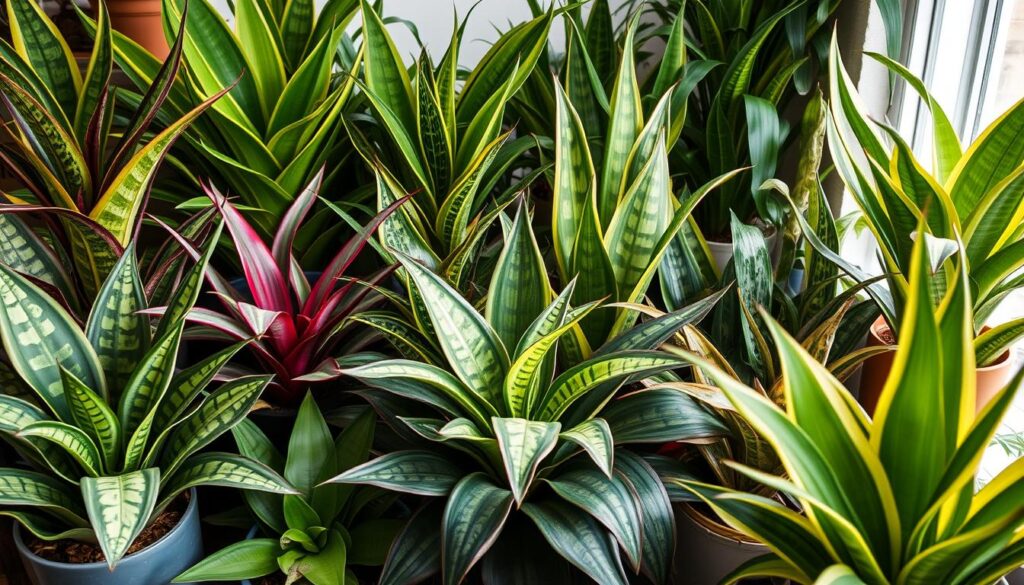
History and Origins of Sansevieria
Snake plants come from the dry lands of West Africa. They have special traits that help them survive in tough places. These plants are part of the Asparagaceae family and have been around for a long time.
Why Snake Plants Are Perfect Indoor Companions
Snake plants are more than just pretty. They have many benefits for indoor spaces:
- They clean the air well
- They need very little water
- They can grow in low light
- They are easy to take care of
Common Names and Scientific Classification
Snake plants are also called by other names because of their unique look:
- Mother-in-Law’s Tongue
- Saint George’s Sword
- Viper’s Bowstring Hemp
They are scientifically known as Dracaena trifasciata (previously Sansevieria trifasciata). These plants are a mix of beauty and toughness. Their tall leaves and ability to adapt make them great for indoor gardens.
Popular Snake Plant Varieties and Their Characteristics
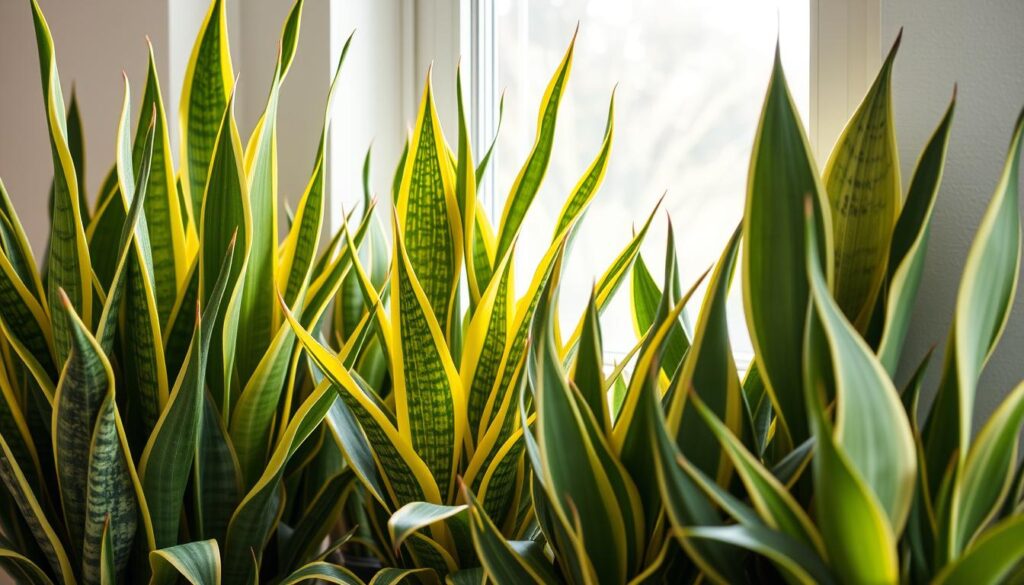
Snake plant varieties add beauty to any indoor space. They come in many shapes, sizes, and patterns. This makes them perfect for both beginners and experienced plant lovers.
Let’s look at some favorite snake plant varieties:
- Sansevieria trifasciata (Mother-in-Law’s Tongue): The classic snake plant with dark green leaves and yellow border
- Sansevieria cylindrica (African Spear): Features unique cylindrical leaves that grow upright
- Sansevieria moonshine: Characterized by silvery-green leaves with subtle dark green markings
- Sansevieria hahnii (Bird’s Nest Snake Plant): A compact variety perfect for small spaces
When picking a snake plant, think about your space, light, and style. Each variety has its own look that fits different decor.
Some snake plants grow tall and bold, while others stay small and quiet. The variety in leaf shapes means you can find the perfect match for your home.
Essential Snake Plant Care Guidelines
Snake plant care is all about knowing what these tough plants need. They do great in indoor spaces, making them perfect for anyone who loves plants.
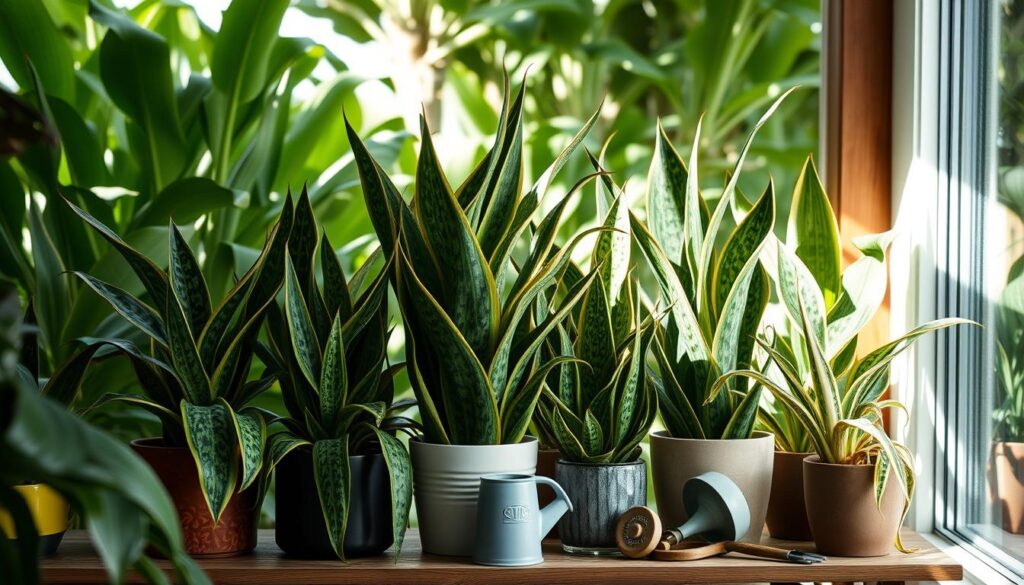
Temperature and Humidity Requirements
Snake plants love temperatures between 60-85°F. They can handle changes in temperature, which is great for any home.
- Ideal temperature range: 60-85°F
- Minimum temperature tolerance: 50°F
- Preferred humidity: 30-50%
Best Location for Your Snake Plant
Snake plants don’t need much light. They can handle low to bright indirect light. For the best growth, put them in spots with moderate to bright indirect sunlight.
| Light Condition | Plant Response |
|---|---|
| Low Light | Slow growth, maintains health |
| Indirect Bright Light | Optimal growth and development |
| Direct Sunlight | Potential leaf scorching |
Seasonal Care Adjustments
Changing your snake plant care with the seasons keeps it healthy. In winter, water less and keep it away from cold drafts. In summer, watch for more light and water.
- Winter: Minimal watering, less frequent fertilization
- Summer: Slightly increased watering, monitor light exposure
- Spring/Fall: Standard care routine
Watering and Soil Requirements for Healthy Growth
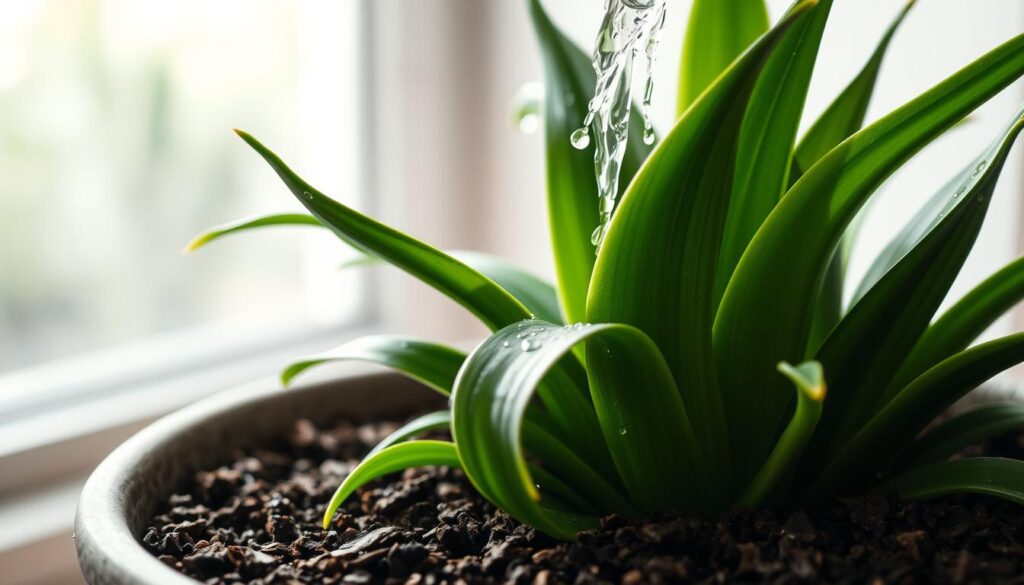
Watering your snake plant is key to keeping it healthy. These plants don’t need much water and do best with a careful watering plan. Finding the right balance helps avoid problems like root rot and keeps your plant thriving.
Drainage is crucial for snake plant soil. These plants need soil that lets water drain quickly to prevent waterlogged roots. A good mix includes:
- Succulent or cactus potting mix
- Perlite for better drainage
- Small amount of sand
- Just a little organic matter
How often to water depends on the season, how much light it gets, and the room’s temperature. In spring and summer, water when the top 2-3 inches of soil are dry. In winter, water much less because the plant is dormant.
Signs you’re watering too much or too little include:
- Yellowing leaves
- Mushy base
- Drooping or wilting
- Brown leaf tips
Pro tip: Always use room temperature water and avoid getting water on the plant’s leaves to prevent potential fungal issues.
Propagation Methods and Tips for Success
Snake plant propagation is a fun way to grow your plant collection. It’s easy to learn and can be done with little effort. This method helps you multiply your snake plants without buying new ones.
There are several ways to propagate snake plants, each with its own benefits. Your choice depends on what you have available, the health of your plants, and what you prefer.
Water Propagation Technique
Water propagation is a great way to reproduce snake plants. Here’s how to do it:
- Select a healthy leaf from your snake plant
- Cut the leaf into 3-4 inch sections
- Place leaf cuttings in clean water
- Ensure the bottom of the cutting is submerged
- Place in indirect light
- Change water weekly
Division Method
Division is best for mature snake plants with many stems. It lets you split established plants into smaller ones.
- Remove the entire plant from its pot
- Gently separate root clusters
- Ensure each division has roots and leaves
- Replant in fresh, well-draining soil
Leaf Cutting Propagation
Leaf cutting is another reliable method. Cut leaves into 2-3 inch sections and plant them in soil or water.
| Propagation Method | Time to Root | Difficulty Level |
|---|---|---|
| Water Propagation | 4-6 weeks | Easy |
| Division | Immediate | Moderate |
| Leaf Cutting | 6-8 weeks | Intermediate |
With patience and the right technique, you can become a pro at snake plant propagation. You’ll soon have a thriving collection of these hardy houseplants.
Troubleshooting Common Snake Plant Problems
Snake plant care needs attention and knowing about common problems. Even with good care, your snake plant might face issues that need quick action and specific fixes.
Spotting common problems early can prevent serious damage. Here are the usual issues snake plant owners face:
- Yellowing leaves mean you’re watering too much
- Brown leaf tips are a sign of low humidity
- Root rot happens when there’s too much water
- Pests like spider mites can be a problem
There are ways to prevent and fix these issues:
| Problem | Cause | Solution |
|---|---|---|
| Yellowing Leaves | Overwatering | Water less often |
| Brown Leaf Tips | Low Humidity | Make the air more humid |
| Pest Presence | Poor Air Circulation | Isolate and treat with neem oil |
Preventive care means keeping the right environment. Always check your plant often to spot problems early.
Most snake plant issues come from wrong watering, light, or stress. Knowing these can help you create the best place for your succulent to thrive.
Health Benefits and Air-Purifying Properties
Snake plants are more than just pretty. NASA found they clean the air by removing toxins like formaldehyde and benzene. This makes your home air cleaner and healthier.
These plants act as natural air filters. They release oxygen at night and take in carbon dioxide. This is great for your bedroom, helping you breathe better while you sleep. Studies show they can also cut down on indoor allergens and stress.
Snake plants also boost your mood and reduce stress. They help you focus better and feel more relaxed. Adding them to your space is like giving yourself a health boost.
To get the most air cleaning, put snake plants in every room. Make sure they get some indirect light and take good care of them. Caring for these plants will give you cleaner air, clearer thinking, and a brighter home.
FAQ
Are snake plants easy to care for?
Yes, snake plants are very easy to care for. They are great for beginners and experienced plant lovers. They can handle low light and need little water, making them very forgiving.
How often should I water my snake plant?
Water your snake plant when the soil is dry. You might need to water every 2-6 weeks, depending on the season. In winter, water even less because the plant is dormant.
Can snake plants purify indoor air?
Yes, they are great at cleaning the air. NASA found they remove toxins like formaldehyde and benzene. They even make oxygen at night, making them perfect for bedrooms.
What type of light do snake plants need?
Snake plants can handle many light conditions. They do best in indirect bright light but can also do well in low light. Just avoid very dark spots or direct afternoon sun.
How do I propagate a snake plant?
You can propagate snake plants in three ways: leaf cuttings, division, and water propagation. Division is the easiest. Leaf cuttings can be rooted in soil or water, but water takes longer.
Are snake plants toxic to pets?
Yes, snake plants can be toxic to cats and dogs. They contain saponins that can upset their stomachs. Keep them away from pets and kids.
What soil is best for snake plants?
Use a succulent or cactus potting mix for snake plants. These soils prevent water from staying too long. You can also mix regular potting soil with perlite or sand for better drainage.
How do I know if I’m overwatering my snake plant?
Overwatering signs include yellow leaves, soft base, and brown spots. Root rot can also happen. Always check the soil moisture before watering and make sure your pot has holes for drainage.
Can snake plants grow in bathrooms?
Yes, snake plants do well in bathrooms because they like humidity. Just make sure they get some indirect light. Bathrooms have consistent temperature and moisture, which is good for these plants.
How tall do snake plants grow?
Snake plant height varies. Some stay short, like 6-8 inches, while others can grow up to 4-6 feet. The height depends on the variety and how well you care for it.




2 thoughts on “The Ultimate Guide to Snake Plants Types, Care, and More”